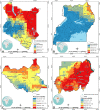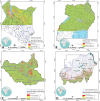Prediction of breeding regions for the desert locust Schistocerca gregaria in East Africa
- PMID: 32686749
- PMCID: PMC7371632
- DOI: 10.1038/s41598-020-68895-2
Prediction of breeding regions for the desert locust Schistocerca gregaria in East Africa
Abstract
Desert locust outbreak in East Africa is threatening livelihoods, food security, environment, and economic development in the region. The current magnitude of the desert locust invasion in East Africa is unprecedented and has not been witnessed for more than 70 years. Identifying the potential breeding sites of the pest is essential to carry out cost-effective and timely preventive measures before it inflicts significant damage. We accessed 9,134 desert locust occurrence records and applied a machine-learning algorithm to predict potential desert locust breeding sites in East Africa using key bio-climatic (temperature and rainfall) and edaphic (sand and moisture contents) factors. Ten days greenness maps from February 2020 to April 2020 were overlaid in model outputs to illustrate the temporal evolution of breeding site locations. This study demonstrated that vast areas of Kenya and Sudan, north eastern regions of Uganda, and south eastern and northern regions of South Sudan are at high risk of providing a conducive breeding environment for the desert locust. Our prediction results suggest that there is need to target these high-risk areas and strengthen ground surveillance to manage the pest in a timely, cost-effective, and environmentally friendly manner.
Conflict of interest statement
The authors declare no competing interests.
Figures








Comment in
-
Why locusts congregate in billion-strong swarms - and how to stop them.Nature. 2020 Aug;584(7822):497. doi: 10.1038/d41586-020-02453-8. Nature. 2020. PMID: 32848215 No abstract available.
References
-
- Cheke RA, Holt J. Complex dynamics of desert locust plagues. Ecol. Entomol. 1993;18:109–115. doi: 10.1111/j.1365-2311.1993.tb01191.x. - DOI
-
- Symmons PM, Cressman K. Desert Locust Guidelines: Biology and Behaviour. Rome: FAO; 2001.
-
- Brader, L. et al. Towards a more effective response to desert locusts and their impacts on food security, livelihoods and poverty. Multilateral evaluation of the 2003–05 Desert locust campaign (Food and Agriculture Organisation, Rome, 2006).
Publication types
LinkOut - more resources
Full Text Sources
Miscellaneous

